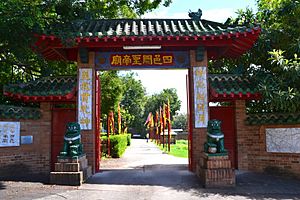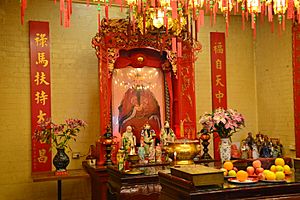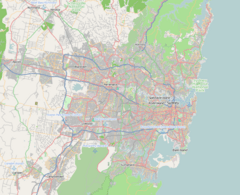Sze Yup Temple facts for kids
Quick facts for kids Sze Yup Temple |
|
|---|---|

Sze Yup Temple entrance
|
|
| Religion | |
| Affiliation | Taoism |
| Deity | Kwan Ti |
| Ownership | Trustees of the Sze Yup Temple |
| Location | |
| Location | Victoria Road, Glebe, City of Sydney, New South Wales, Australia |
| Country | Australia |
| Architecture | |
| Architectural type | Temple |
| Architectural style | Chinese |
| Completed | 1898–1904 |
| Official name | Sze Yup Temple & Joss House; Sze Yup Kwan Ti Temple; Joss House; Chinese Temple |
| Type | State heritage (complex / group) |
| Designated | 2 April 1999 |
| Reference no. | 267 |
| Type | Buddhist Temple |
| Category | Religion |
The Sze Yup Temple (which means "Four Counties Kwan Ti Temple" in Chinese) is a special Chinese temple and Taoist place of worship. It's located in Glebe, a suburb of Sydney, Australia. This temple was built between 1898 and 1904. It's also known as the Sze Yup Kwan Ti Temple, named after the god it honors, Kwan Ti. The temple is owned by its Trustees and was added to the New South Wales State Heritage Register in 1999. It's one of only four Chinese temples in Australia built before World War I that are still actively used today.
The Sze Yup Temple honors Kwan Ti (also known as Guan Di). He is a popular god based on Guan Yu, a famous military leader from ancient China's Three Kingdoms period. The temple's design and its surrounding area show the traditional building style from the Sze Yup counties in Guangdong, China. The main hall, built in 1898, holds the shrine for Kwan Ti. Later, in 1903, eastern and western halls were added. One of these is a hall for ancestors, and the other is for Caishen (Choi Buk Sing), the god of wealth.
Contents
Temple History

How the Temple Started
When Chinese settlers in Sydney wanted to build a temple for the Chinese hero and god, Kwan Ti, they looked for a special place. They believed a sign led them to a market garden in Glebe. They bought this land in 1897. The money for the temple came from immigrants who came from the Sze Yup (Four Districts) area of Guangdong province in China.
The idea to build the temple came from the Sze Yup community in New South Wales in the early 1890s. This was a difficult time in Australia, with many challenges and some racial tension. People from Sze Yup County were known for being very religious. Local Chinese groups, like the Chinese Masonic Society, supported the plan. They also got advice from the Sze Yup Temple Trustees in Melbourne. Funds were raised through community contributions and donations.
The Sze Yup Temple is dedicated to Kwan Ti, a brave warrior and loyal figure from the Three Kingdoms era (220-265 AD). Kwan Ti is famous for his loyalty, strength, and courage. In Australia, Chinese immigrants prayed to him as a wise judge, a guide, and a protector. Many important business decisions were made only after asking Kwan Ti for his guidance and blessing.
The main part of the Sze Yup Temple was built in 1898. It's a simple red brick building designed with Feng Shui principles in mind. This means it was placed on land that sloped down towards Rozelle Bay, which was considered good luck. Inside, there's an altar with embroidered pictures of Kwan Ti and his guards. There are also racks holding Kwan Ti's Red Hair Horse and weapons. You can see engraved messages, prayers, a huge drum, a gong, and two beautiful carved columns from 1898.
Temple Development and Community Role
In 1904, two more chapels were added to the temple: the Chapel of Departed Friends and the Chapel of Good Fortune. For the Chinese community in Sydney, the Sze Yup Temple was more than just a place to worship. It was a cultural hub where people could meet friends and find support. It offered help or a place to stay for travelers, new immigrants, and those who were sick.
Many colorful festivals and celebrations, like the Chinese New Year, took place at the temple. It was also used to temporarily store the bones of people who had passed away. This was done before their bones were sent back to China for permanent burial, as was the tradition.
Over the years, the temple faced challenges, especially during the time of the White Australia Policy, which made it harder for Chinese people to come to Australia. This meant fewer people were able to help with the temple's upkeep. However, after the policy ended in the 1970s, more Chinese immigrants arrived, and donations to the temple increased.
In 1985, a special order was made to protect the temple and its grounds as a heritage site. This means it's recognized as an important historical place. In 1983, a large gateway and a wall were added around the temple complex. Even after more than 100 years, the Sze Yup Temple remains a sacred place for the Chinese community. Today, worshippers include new arrivals from many different countries, including Hong Kong, Malaysia, Singapore, Taiwan, China, and Indo-China.
Temple Features
The Sze Yup Temple is located on a block surrounded by Victoria Road, Edward Street, Eglington Lane, and Edward Lane. The main entrance is on Edward Street, marked by a masonry fence and a large gateway.
The central part of the temple is made of red brick, similar to village temples in southern China. Above the entrance, there's a sign that says "The Temple of Kwan Ti." The temple has three halls, separated by outdoor passages and covered with small pitched roofs. This is a common temple design. The front porch has a curved roof and cast-iron columns. The brickwork shows a mix of traditional Chinese and Edwardian styles.
Inside the temple, you'll find an altar with embroidered pictures of Kwan Ti and his guards. There are also racks holding Kwan Ti's Red Hair Horse and weapons. Engraved messages and prayers hang on the walls, along with a huge drum and a gong. Two beautiful carved columns from 1898 were originally meant for another part of the temple but were too tall. On the wall, four sets of couplets praise Kwan Ti's good qualities and wish for peace.
The temple was originally built facing Blackwattle Bay, which was important for good Feng Shui. This traditional Chinese belief system helps decide the best location and layout for buildings to bring good fortune. The land in front of the temple was later bought and cleared to keep this important view open. This is why no buildings have been constructed directly in front of the temple.
The central chapel is surrounded by two other chapels: the Chapel of Departed Friends (to the north) and the Chapel of Good Fortune (to the south). The site also has separate toilet facilities and a storage shed.
Temple Condition and Changes
The temple is in excellent condition, and most of its important features are well-preserved. The original layout of the grounds remains, and many plants from the early to mid-20th century are still there. Some changes were made in the late 20th century, like adding ventilation systems, replacing a skylight, and building a new entrance gate, perimeter wall, and small service buildings (like the toilet block and storeroom). These changes have helped the temple continue to be used and valued.
Here are some key dates for the temple:
- 1898: The first part of the Temple was built.
- 1904: Two more temple chapels or wings were added.
- 1953: A fire damaged the roof of the central hall and some furnishings. It was rebuilt in 1955.
- 1978: The temple was partly restored, including new roofing, painting, drainage, ventilation, and lighting.
- 1981: A new toilet block was built.
- 1982: An archway was added to the temple complex, with two stone lions guarding the entrance.
Why the Temple is Important
The Sze Yup Temple is very important to the history and culture of New South Wales. It's a rare and well-preserved example of a Chinese temple in Australia. It's one of only two places of worship for Chinese people in New South Wales that existed before the 1960s. It's also one of just four early Chinese temples (built before World War I) that are still active in Australia.
The Sze Yup Temple has been continuously used by the Chinese community since it was built. It's a central place for the Sze Yup community in New South Wales and for anyone interested in traditional Chinese culture and beliefs. This temple is considered important both locally and internationally.
The Chinese community played a big, though often unrecognized, role in Australia's development in the 1800s. They helped with mining, farming, and furniture-making. Later, they contributed to Australia's import and export businesses. In many parts of Australia in the 19th century, there were times when more Chinese people lived there than European residents.
The temple and its grounds show the architectural styles and landscaping from the Sze Yup County in Guangdong Province, China. The building's design is similar to many "village" temples from that area. The Glebe Temple successfully used local materials and building methods, and it is in excellent condition.
The temple's location and design also show the principles of "Feng Shui." This traditional belief system influenced how the buildings and landscape elements are placed. The temple's view towards Rozelle Bay and Balmain in the north-west is an important part of its Feng Shui.
The temple is dedicated to Guan Di (Kwan Ti), a respected military figure from the Three Kingdoms Period (220-280 AD). Guan Di is worshipped by Chinese people all over the world. The temple is well-known for bringing "good luck."
The main hall, built in 1898, holds the Guan Di shrine. The eastern and western halls, added in 1903, are for honoring ancestors and for Cai Bai Xing (Choi Buk Sing), the popular god of wealth. Families who have memorial plaques in the Ancestral Hall or who have donated to the temple feel a strong connection to it.
The temple and its grounds are used for large community celebrations throughout the year, as well as for individual worship. Over time, many Chinese organizations that practice traditional activities like martial arts and lion dances use the temple for practice and performances. This helps the temple continue to be a central part of the local Chinese community.
The Sze Yup Temple was officially listed on the New South Wales State Heritage Register on April 2, 1999.
Historical Significance
The site has been used by Chinese people since at least the 1880s, when a Chinese market garden was located here. The temple and its contents give us information about the lives of the Chinese community in Australia from the late 19th century, which is often not well documented.
The Glebe Sze Yup Kwan Ti temple, built between 1898 and 1904, is the only actively used Chinese temple in Australia from before World War I that still has its original setting and views. Other old temples in cities have lost their original rural surroundings.
Community Connections
The temple has strong ties to the Sze Yup Chinese community in New South Wales and other states. The Sze Yup counties in Guangdong Province were a major source of immigrants to Australia in the 19th century.
The Sze Yup temple has been a cultural, religious, and social center for the Sze Yup community and others since 1898. The temple's Trustees helped community members by offering temporary housing, financial support, and help in keeping in touch with families in China. They also arranged for the storage and transport of the bones of Sze Yup-born people back to China for permanent burial.
The temple strongly shows a sense of community identity and history. Painted and carved panels inside the halls list the original donors to the Temple, and some people in the community can still identify their ancestors and relatives. After changes to immigration laws in the early 1970s, the temple became a cultural and religious center for many Chinese settlers who came from Vietnam and nearby countries. The temple has become well-known for its "good luck," which is believed to come from its favorable setting for its gods and ancestral tablets.
Unique Features
The temple building is a rare example of a traditional three-hall temple layout that also includes Edwardian-style building elements. This shows how local materials and building techniques were adapted. For example, it has corrugated iron roofs and a curved corrugated iron porch roof supported by cast-iron columns.
The decorations and objects inside the temple, which came from China, are excellent examples of Chinese decorative arts from the late 19th century. Many similar pieces in China and elsewhere have been damaged or destroyed over time, making these items very valuable.
The temple's location among old, culturally important trees and its view of Blackwattle Bay show a rare and well-preserved example of "Feng Shui" – traditional practices for planning buildings.
Research Potential
The temple building shows how traditional Chinese beliefs were adapted to local conditions and materials. The building's layout, landscape, structures, fixtures, and decorations offer areas for future research into the cultural and spiritual importance of Chinese beliefs.
There might be archaeological findings around the temple that could provide information about Chinese presence in this area before 1898, and from 1900 to the 1970s.
The layout and location of the temple building show how the traditional Chinese belief system of Feng Shui was applied. Elements of Feng Shui include keeping clear views, especially the temple's north-western outlook to the skyline and water. It also includes the placement and relationship of structures and plants, and the building's direction and size. This aspect has made the place more culturally significant over time, as its "good" Feng Shui becomes more widely known.
Rarity
The Glebe Sze Yup temple is the only Chinese temple from the 19th century still standing in New South Wales. It is one of only five intact 19th-century temple structures known in Australia. The others are in Atherton, Breakfast Creek, South Melbourne, and Bendigo. The Glebe Sze Yup temple is the only active, early Chinese temple in Australia that still has its original setting and views. The temple has been continuously used by the Chinese community since 1898.
Architectural Style
The building shows the three-hall layout common in many southern Chinese village or small town temples. This one-hall and three-hall layout was seen in all Chinese temples built to serve Chinese communities in Australia in the 19th century.
The temple's design reflects the size and simple decorative features of temples in the Sze Yup (Four Counties) area of Guangdong Province, south of Guangzhou.
Images for kids




